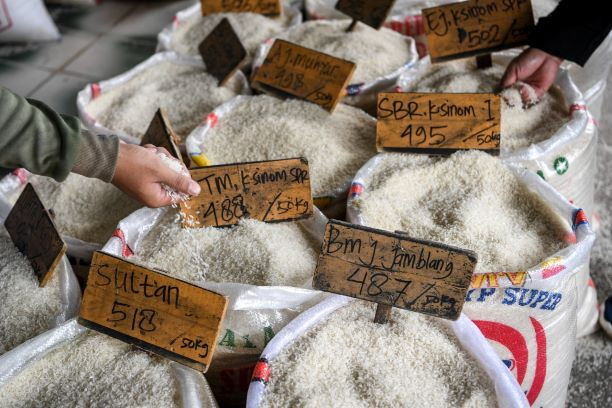Popular Reads
Top Results
Can't find what you're looking for?
View all search resultsPopular Reads
Top Results
Can't find what you're looking for?
View all search resultsA blessing in disguise?
The positive trend is unlikely to last long, given the relaxed implementation of restrictions and the reopening of regional borders.
Change text size
Gift Premium Articles
to Anyone
 All rise: A customer checks the quality of rice in Cipinang market in East Jakarta on Oct. 4, 2022. Statistics Indonesia said inflation hit 1.17 percent in September, the highest monthly rate since September 2014, with fuel and rice prices and city transportation fare hikes the primary contributing factors. (AFP/M Risyal Hidayat)
All rise: A customer checks the quality of rice in Cipinang market in East Jakarta on Oct. 4, 2022. Statistics Indonesia said inflation hit 1.17 percent in September, the highest monthly rate since September 2014, with fuel and rice prices and city transportation fare hikes the primary contributing factors. (AFP/M Risyal Hidayat)
T
he year 2022 concluded with a slightly higher-than-expected headline inflation of 5.51 percent. On the positive side, however, this achievement was a direct reflection that the heart of the domestic economy had started to beat again, albeit not at a robust pace.
Last year’s inflation outperformed Bank Indonesia’s (BI) and several global financial institutions’ expectations at around 5.4 percent.
Not just on the headline section, core inflation, the main indicator of domestic demand, also soared at around 3.36 percent on a yearly basis in December, marking the highest level in 2022.
For some, a high level of inflation might seem like a “terror” to the economy. However, just like a “blessing in disguise”, the number actually indicated a rebound in domestic consumption, which was the main backbone of the country’s engine of growth.
That growing demand subsequently spurred orders for locally produced value-added goods, inching the way for a more positive outlook for manufacturing industry at the beginning of this new year.
Citing S&P Global subsidiary and financial research firm IHS Markit’s data, Indonesia’s manufacturing purchasing managers’ index (PMI) in December was up 0.6 points from the month before to 50.9, ending two months of sluggish growth.
The data also highlighted that the manufacturing sector had been in the expansion zone throughout 2022, only this time around it was mostly supported by domestic demand instead of international orders.
As price pressures began to ease at the last quarter of last year, input-cost inflation was also axed below the average level in the final month of 2022 to mark a 19-month low in selling price inflation that led to a flurry of orders.
As a result, higher domestic demand for local manufactured goods had created a better underlying situation, driving firms to expand production to fulfill new orders in December as well as creating more optimistic and upbeat prospects for manufacturers as they entered 2023.
More good news: manufacturers also marked six straight months of workforce recruitment to fulfill the higher demand by increasing preproduction and finished-goods inventories.
Not just in Indonesia though, the beginning of “spring season” for the manufacturing sector also unfolded in emerging economies in the Asia Pacific region, namely Thailand and China.
While advanced economies suffered from contraction in manufacturing production, their developing counterparts started to flourish.
According to a report titled ICAEW Economic Insight Forum Q4 2022, the phenomenon was mainly due to delays in opening the region’s borders, which contributed to an increase in domestic orders, leading to an “above average” increase in demand.
Still, no windfall will last forever. The very same report also projected that the positive trend is unlikely to last long, given the relaxed implementation of restrictions and the reopening of regional borders.
Broadly speaking, the decline in manufacturing production in Asia’s developed countries will ultimately hamper the region’s overall production growth.
On the other hand, Indonesia’s GDP outlook for this year is also expected to dim. Even though growth amounted to 5.72 percent on an annual basis in the third quarter of 2022, going forward with the global situation and the threat of a recession, Indonesia’s economic performance is predicted to decline.
Nonetheless, there is still hope that the situation will slowly improve with the projected increase in people's demand for local manufacturing products. Especially since domestic demand is estimated to contribute 6 percent to the GDP growth in 2023.
This alone can act as a deterrent in suppressing the threat of an impending global recession.










